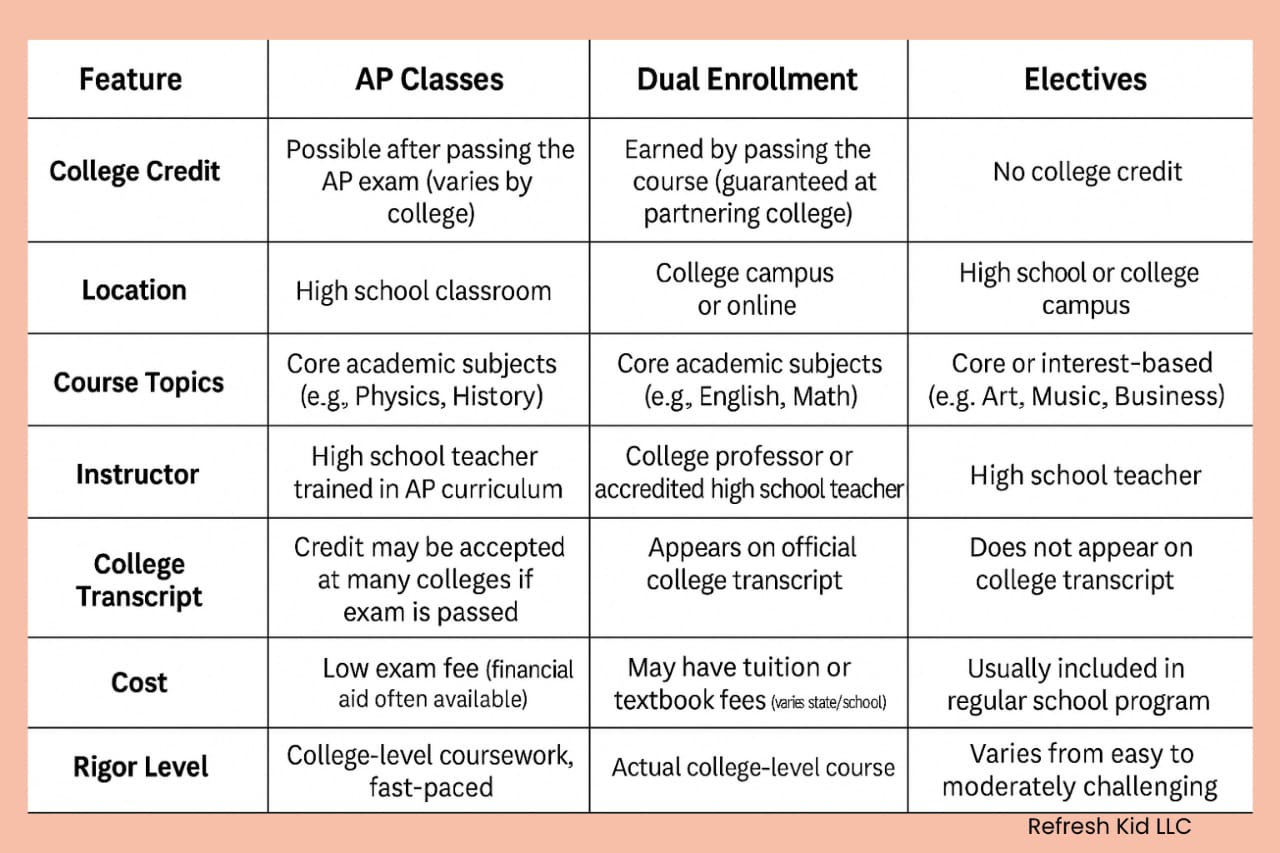Helping your child plan their high school journey can feel overwhelming. Terms like AP Classes, Dual Enrollment, and Electives get thrown around a lot, but what do they actually mean? More importantly, how can you help your middle schooler make the best decisions?
In this guide, we break down everything parents need to know about these options, including the difference between electives and AP classes, what dual enrollment is in high school, and how to compare college credit AP vs dual enrollment. You’ll also get tips on how to choose electives in high school and understand the benefits of dual enrollment.
To dive deeper into AP programs, visit our AP Course Guide on Refresh Kid.

What Are AP Classes in High School?
AP stands for Advanced Placement. These are college-level classes offered in high school.
Key Features:
- Created by the College Board (official site)
- Available in subjects like AP Biology, AP Calculus, AP US History, and more
- Students take an AP exam at the end of the course
- High scores (usually 3 or above) may earn college credit
Example:
If your child takes AP Chemistry in 11th grade and scores a 4 on the exam, many colleges will give them credit as if they had completed a first-year college chemistry class.
Benefits of AP Classes:
- Show academic rigor on college applications
- Opportunity to earn college credits and save on tuition
- Prepare students for the pace and expectations of college
- Help qualify for scholarships and advanced placement in college courses
Tip:
Some high schools have prerequisites. For example, a student may need to complete Algebra II before taking AP Calculus AB.
How to Register:
Students typically register for AP classes through their high school counselor during course selection. To register for AP exams, schools usually coordinate directly with the College Board. For homeschool or independent students, visit the College Board AP Registration Page for guidance.
What Is Dual Enrollment in High School?
Dual Enrollment allows high school students to take real college courses, either at a local college or online.
Key Features:
- Students earn both high school and college credit at the same time
- Typically available to juniors and seniors
- Usually offered through local community colleges or universities
Example:
A 12th grader might take an English Composition course at a local community college. This course counts as both high school English credit and college credit.
Benefits of Dual Enrollment:
- Save money on college tuition
- Get a real taste of college life and academics
- Flexible options, including online and in-person classes
- Develop time management and independence
If you’re interested in official information about how dual enrollment works nationwide, check out the U.S. Department of Education’s guide.
How to Register:
Registration varies by state and college. Typically, students work with their high school counselor to apply to a local partner college or university. Some programs require placement tests. For example, students in California can register through their community college system via CCCApply, while Florida students use FloridaShines.
Difference Between Electives and AP Classes
Understanding the difference between electives and AP classes is key to making smart decisions.
Electives:
- Courses chosen based on interests (e.g., art, photography, journalism, coding)
- Help students explore hobbies, passions, or career paths
- Typically do not provide college credit
AP Classes:
- Rigorous academic classes
- Align with college-level standards
- Students take an exam to potentially earn college credit
Summary:
| Feature | Electives | AP Classes |
|---|---|---|
| Purpose | Explore interests | Academic rigor + college credit |
| Credit | High school only | Possible college credit |
| Difficulty | Varies | College-level |
AP Classes vs Dual Enrollment: What’s Better?
Comparing AP classes vs dual enrollment can help you choose the best path for your child.
AP Classes:
- High school teacher teaches the course
- Credit depends on AP exam score (1 to 5 scale)
- Recognized nationally and internationally
Dual Enrollment:
- Actual college professor teaches the course
- Credit earned based on course grade (no separate exam)
- Credits may not always transfer across all colleges
College Credit: AP vs Dual Enrollment
| Factor | AP Classes | Dual Enrollment |
|---|---|---|
| Credit awarded | Based on exam score | Based on course grade |
| Credit transfer | Widely accepted | Varies by college or state |
| Cost | Often free or low-cost | May have tuition or fees |
| Format | Taught in high school | Taught at college/online |
| Schedule | Semester/Year-long | Varies (semester or quarter) |
To compare how credits transfer, check the Transfer Credit Tool.
How to Choose Electives in High School
Not sure how to choose electives in high school? Here’s a step-by-step guide for parents.
Step-by-Step Guide:
1. Think About Interests
- Is your child artistic? Try graphic design or theater.
- Do they love science? Consider robotics or environmental science.
2. Explore Career Skills
- Courses like business, coding, or public speaking can build real-world skills.
3. Balance Fun and Academics
- It’s okay to have a mix! A fun elective can keep school exciting.
4. Ask About Future Courses
- Some electives lead to advanced classes in later grades (e.g., Intro to Computer Science → AP Computer Science A).
5. Talk to the School Counselor
- They can help match electives with graduation requirements and college goals.
Students can also test the waters with enrichment programs like those offered in Refresh Kid’s Summer Prep Courses.
Benefits of Dual Enrollment for College Preparation
The benefits of dual enrollment go beyond just saving money.
Academic Benefits:
- Exposure to college-level work
- Develop college-level writing and thinking skills
- Learn how to manage a syllabus and deadlines independently
Financial Benefits:
- Fewer credits needed in college
- Reduce student loan debt
- Qualify for state or federal programs supporting early college programs
Emotional Growth:
- Build confidence
- Experience new environments
- Meet a diverse group of peers
Summary Table: AP Classes vs Dual Enrollment vs Electives
| Feature | AP Classes | Dual Enrollment | Electives |
| Purpose | College-level academic challenge | Earn college credit while in high school | Explore interests and develop soft skills |
| Taught By | High school teachers | College professors (or approved instructors) | High school teachers |
| Credit Type | High school + potential college credit (via exam) | High school + direct college credit | High school credit only |
| Credit Basis | AP exam score (1–5) | Final course grade | Course completion |
| Recognition | National/international | Varies by state/college | Internal (school-specific) |
| Cost | Usually free or low-cost | May involve tuition or fees | Free as part of high school schedule |
| Transferability | Widely accepted by colleges | Depends on college/state | Not intended for college transfer |
| Scheduling | Within high school schedule | May require travel or online attendance | Built into school day |
| Registration | Through high school counselor, AP exam via College Board | Via counselor and college application (e.g., CCCApply) | High school course selection period |
How Can Middle School Parents Help Prepare for High School Choices?
It’s never too early to start planning. Middle school is the perfect time to start exploring options.
Actionable Steps:
1. Understand Your School’s Offerings
- Check what AP classes, dual enrollment, and electives your child’s future high school offers
- Ask about any prerequisites for AP classes
2. Encourage Academic Curiosity
- Help your child explore subjects they enjoy
- Sign up for summer camps or online enrichment with trusted platforms.
3. Build a Strong Academic Foundation
- Focus on core skills like reading, writing, and math
- Good grades in middle school can open more doors in high school
4. Stay Involved
- Attend school info nights
- Join parent-teacher groups
FAQs: College Credit, Dual Enrollment, and AP Classes
Q: Can a student do both AP classes and dual enrollment?
A: Yes! Many students do both, depending on their schedule and goals.
Q: Are AP classes harder than dual enrollment?
A: Not always. AP classes are rigorous, but dual enrollment involves real college coursework. It depends on the student’s strengths and the course content.
Q: Do colleges prefer AP or dual enrollment?
A: Most colleges accept both. What matters more is academic rigor, consistency, and performance. Competitive colleges often favor AP because of national standardization.
You can explore how AP credits are accepted by visiting the College Board’s Credit Policy Search.
Q: Can AP or dual enrollment classes replace core graduation requirements?
A: Often, yes. For example, AP U.S. History can replace standard U.S. History, and dual enrollment English can fulfill the English requirement.
What to Watch Out For with AP and Dual Enrollment
1. Burnout
Taking too many rigorous courses at once can overwhelm students. Balance is key.
2. Credit Transfer
Not all colleges accept dual enrollment credits, especially out-of-state private universities. Check using the Transfer Credit Tool.
3. Quality of Instruction
Dual enrollment courses taught on college campuses often have more academic depth than those offered in high school buildings.
4. Conflicting Schedules
College classes may not align perfectly with high school bell schedules.
AP Classes, Dual Enrollment, and Electives – Build a Personalized Plan
As a parent, your support is crucial. By understanding AP Classes, Dual Enrollment, and Electives, you’re already ahead of the curve. Help your child build a high school plan that suits their strengths, passions, and college goals.
To explore more support resources and tutoring options, visit Refresh Kid where we guide families through academic planning.
Still unsure? Book a free academic consultation and let us help you plan your child’s success journey.




